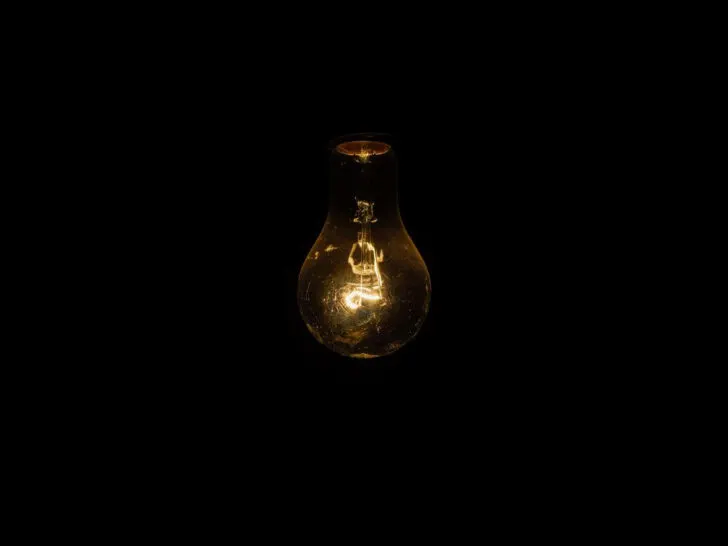When a light bulb has a label of 60W, this means that every second you use the bulb will consume 60 joules of energy. Every bulb has a resistor, and when a light bulb has a 240 Ohm label, this indicates the resistor used to control current and lower the power.
Physics is indeed hard to understand, particularly the topics related to electricity. You need to remember just so many things, and sometimes you might get confused, especially on technical concepts on this 60-watt and 240-ohm light bulb.
Before we get to that, we need to understand what watts, electrical field, current, resistance, voltage, and other electrical terms mean. So, let’s get right to it!
What Does Watts Mean? (Power)
The “watt” is considered a unit of power or radiant flux. Its symbol is “W.”
It’s known to be a method of measuring the rate of energy being transferred to an appliance. For instance, a one-watt light bulb will change one joule of electrical energy into light energy each second. Therefore, it’s consuming one joule of energy.
So basically, watts are a measure of an appliance’s power. It’s the electrical unit for the energy produced and consumed rate. Therefore, you could say that power consumption is measured in watts.
There are also kilowatts (kW) that measure the power consumption for larger devices. One kilowatt will be equal to a thousand watts.
Watts is a unit of power named after the engineer James Watt. In electrical terms, a watt is the rate at which the electrical work is done when one ampere (A) of current flows through one volt (V).
The formula for Watt is W= A x V, and one watt is equal to one joule per second. The higher the wattage, equal more power or energy is supplied to a device.
What is Ohm? (Resistance)
On the other hand, Ohm in the International System of Units (SI) is used to measure the electrical resistance of a material or an electronic device.
For example, one ohm is basically the amount of resistance in a conductor through which a current of one ampere flows when a potential difference (voltage) of one volt is applied to the circuit.
In short, “resistance” measures opposition to current flow in an electrical circuit. Its symbol is Ω, the Greek letter for omega.
What’s the Resistance of The Filament Following the Doubling of its Length?
If you look at it in simple terms, then resistance is anything that can withstand a force or an effect. The same is the case in a circuit or a light bulb. Resistance acts as a force that defies the current flow in the circuit.
Light bulbs have a filament that holds resistance. The filament in an incandescent light bulb doesn’t have a constant resistance. If you increase the voltage across it, the current will increase.
This increase in current will make the bulb hot, and that’s how it glows. And as the temperature increases, the resistance increases in a light bulb.
However, resistance and current are inversely proportional, as when the resistance of a filament in the light bulb increases, the current flowing through the filament will decrease.
What’s an Electric Current?
The electric current measures the flow of electric charge across a surface at one coulomb per second (ampere).
You should measure the charge in coulombs and the time in seconds. The unit of current is coulomb/second (C/S) or amp.
An electric current is a stream of charged particles, such as electrons and ions, which move through an electrical conductor or space. As this movie takes place, there’s a production of heat, magnetic fields, and even chemical transformations.
It’s the amount of flow charge through any cross-sectional area of a conductor.

Electric current is what provides a light bulb with power and charge. When the bulb is hooked to a power supply, the electric current flows through the wires and filament from one end to another. It remains constant throughout.
Moreover, it’s related to the voltage and resistance in a circuit. The formula for current is I (current) is equal to V (voltage) divided by R (resistance). It can be written in this form: I = V/R.
What’s Voltage? (Current vs. Volts)
In simple words, voltage is what makes electric charges move. It can be described as the pressure that pushes the charges through an electrical conductor.
The name “Volt” for voltage was established in honor of Alessandro Volta, an Italian physicist. An example of voltage can be the specific amount of electricity available in a circuit.
As stated earlier, moving charges can be described as a current. Since voltage causes the charges to move, one can say that voltage is causing current to flow in a circuit.
Voltage is considered a difference in the electric potential between two points. At the same time, the current is regarded as the flow rate of an electric charge. It’s the rate at which electric charges flow in a circuit from one point to another.
Here’s a table summarizing the formulas for different electrical terms:
| Electrical Term | Formula |
| Current (Ampere) | I = V/R |
| Voltage (Volts) | V = I x R |
| Resistance (Ohms) | R = V/I |
| Power (Watts) | W = V x A |
| Electric Field | E = V/L (L= length) |
What Do You Mean by 60 Watt Light Bulb?
A 60-watt rating on a light bulb indicates that it consumes joules of energy for each second the light bulb is switched on. According to this, in 60 minutes, it would mean that the light bulb used 216,600 joules of energy.
An incandescent light bulb that’s 60 watts gives off 800 lumens of light. On the other hand, LED bulbs, which are more efficient in terms of energy saving, are actually able to produce the same amount of light but use as little as 10 watts only.
Lumens are used to measure brightness. So basically, a 60-watt bulb producing 800 lumens of light shows that this is how bright the bulb is.
Moreover, watts are always related to voltage. So, a 60 W light bulb with its rated voltage would mean a lot.
For example, if the label on the bulb states “60 W, 220 V”, then this would mean that it should be connected to a supply of 220 voltage, to function by consuming 60 watts.
What Do 240 Ohms in a Light Bulb Mean?
240 Ohms in a light bulb is considered the amount of resistance because the measurement for resistance is ohms.
As you all know by now, the light bulb contains a filament of a certain length. This filament acts in a way as a resistor.
What is a resistor, you may ask? Well, a resistor is an electrical component that stops the flow of current/electrons in an electrical circuit.
In the case of a light bulb, the filament acts as a resistor limiting the flow of current/electrons. Therefore, 240 ohms is the resistance that is affecting the current. As a result, the lost energy heat is generated, which produces energy in the form of light.
Using this knowledge, the higher the resistance in the filament of a light bulb, the higher the amount of current/electrons will be limited from flowing.
Also, the more the number of current/electrons is limited, the higher the amount of energy will be converted to heat energy, which affects the light energy.

What’s the Resistance of a 240v 60w Bulb?
I already mentioned that it has 240 resistance. However, you might be asking for its working resistance.
We already know that V=RI, therefore the solution will be as follows:
240=R x 0.25
R=240/0.25
=960
Hence, the working resistance of the bulb is 960 ohms.
What’s a Filament?
A filament is considered a wire with an extremely high melting point that is an essential part of a light bulb. This part of the light bulb is crucial as it’s the one that creates light.
Filaments always have to have extremely high melting points as the heat generated due to resistance reaches over 2000 Degrees Celsius. These high temperatures allow a filament to create the bright light that we use in our homes today.
The common element used for filaments is tungsten due to its extremely high melting point because it contains solid metallic bonds.
The filament in a light bulb has to be sealed in a vacuum (any space that does not have any matter) to avoid burning up. Due to extremely high temperatures, any presence of oxygen in the chamber around the tungsten filament will cause the tungsten to catch fire.
But with a lack of oxygen in its chamber, the tungsten filament does not catch fire and glows to illuminate our household.
There are four commonly used arrangements of the tungsten filament in a light bulb:
- Quad Loop Filament
- Spiral Filament
- Hair Pin Filament
- Squirrel Cage Filament
What’s an Electric Field?
An “Electric Field” can be described as a physical field surrounding electrically charged particles and exerting a force on other charged particles.
Electric Field in a 60cm Filament Supplied with 120 Volts
So now that we know what an electric field is, let’s understand how a potential difference of 120 volts across a 60cm filament can give us an electric field of 200 V/m.
It’s important to remember that voltage is measured in Volts, and you must measure the length in meters. As given in the statement above, the filament size is 60cm, which can also be denoted as 0.6 meters.
Furthermore, when it comes to an electric field, a light bulb with 120 volts will have a strength of 200 volts per meter. To find out the electric field, one must divide the voltage by the length of the filament.
According to Michael Faraday, using these two values, we can plug them into the Electric Field formula.
This formula is equal to the voltage (in Volts) divided by length (in meters).
E = V/L
E=120V/0.6m
E=200V/m
This is how voltage and length are used to determine the Electric Field of a specific item, in this case, a filament.
Bottomline
- Watts (W) show energy usage: 60W = 60 joules/second.
- Kilowatts (kW) are for bigger devices: 1 kW = 1000 watts.
- Ohms (Ω) measure resistance control current flow.
- Resistance rises as a bulb’s filament heats up.
- Electric current (I) = V/R (voltage divided by resistance).
- Voltage (V) drives charges and causes current flow (V = I x R).
- A 60W bulb emits 800 lumens of light.
- Two hundred forty ohms is a bulb’s resistance level.
Other Articles
- THE DIFFERENCE BETWEEN 2ΠR AND ΠR^2
- DIFFERENCE BETWEEN THE FORMULA V=ED AND V=W/Q
- WHAT IS DELTA S IN CHEMISTRY? (DELTA H VS. DELTA S)
The web story version of this article can be found when you click here.

